#Textile Dyeing
Explore tagged Tumblr posts
Text
okay so last week i posted about a 1970s fabric dyeing book
i'm going through the scanned pages and the recipes are very neat


this lavender & rosemary recipe will probably be gorgeous, and you can't go wrong with a classic madder red
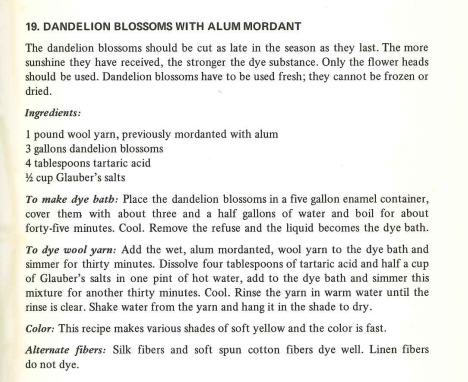

i'm OBSESSED with the idea of using dandelions!!! its already too hot in my area for them to grow, but i will wait for next april


this fall i'll test the marigolds! they've naturalized in my yard and they practically overtake the grass, so they won't mind

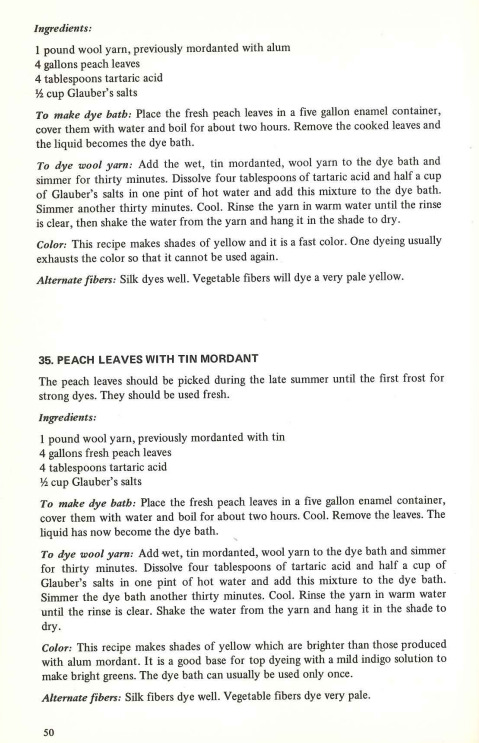
we planted a peach tree back in 2021 and i have never heard of using peach leaves for dye!!! this one i will do ASAP since the squirrels ate all of our peaches this year :(
there are a ton more recipes in this book, so i'll link a part 2 when it's posted!
68 notes
·
View notes
Text

shibori dyeing part 1 ✨
20 notes
·
View notes
Text
A dying experiment to see if I can salvage a wearable muslin that looks like I've murdered a 70's couch and am wearing its skin as a suit!


(This has been sitting in my drafts for about a year now. Since I'm dyeing next week, it seemed like a good time to post!)
9 notes
·
View notes
Text
I don't know who needs to hear this, but
YOU DO NOT NEED TO START A NEW HOBBY!
STEP AWAY FROM THE TEXTILES!
YOU DON'T NEED MORE YARN!
THAT FABRIC IS NOT CALLING TO YOU! LEAVE IT ALONE!
#Mom can you pick me up I'm scared#That siren song is playing again#But wouldn't it be neat to dye spin weave sew knit crochet tat#OMG save me#Hobbies#Textile Arts#Crochet#Knitting#Weaving#Spinning yarn#Cross Stitch#Quilting#Never has Grandma Iris' voice been so loud in my head#(Miss you forever Grandma Iris)
132K notes
·
View notes
Text
Textile Dyeing Industry in India | 9041070303
Textile Dyeing Industry in India
Are you in search of a reliable partner to fulfill your chemical needs for textiles? Look no further than Nano Tech Chemical Brothers! We specialize in creating an exceptional product line to cater to diverse requirements, particularly in the textile industry and garment printing inks. Our focus remains on sustainability and environmental responsibility while delivering top-notch solutions. Textile Dyeing in India
Dyeing Auxiliaries Excellence
When it comes to dyeing auxiliaries, our offerings stand out in the Indian market. We bring you products with superior levelling properties, ensuring uniform dye distribution. Here are some key features and benefits of our products:
High Soaping and Washing Abilities: Our products excel in cleaning and washing, ensuring a pristine finish.
GOTS Approved: Our products are approved by the Global Organic Textile Standard, reflecting our commitment to quality and standards.
Specialized Formulations: We offer products designed for controlled acrylic dyeing, rinsing off reactive and vat dyes, and enhancing wet treatment fastness on cellulose fibers and blends.
Versatility: Our range caters to cotton fabrics and various blends, making it versatile for different textile applications.
Advanced Dyeing Solutions
In addition to the above, our advanced dyeing solutions include:
New Generation Levelling: Achieve exceptional results with reactive dyeing, thanks to our innovative products.
Dispersing and Levelling: Ensure even and bright shades while enhancing shade fastness.
Explore Our Diverse Offerings
Apart from textile dyeing, we extend our expertise to several other industries:
Thread Lubricants: Enhance the performance of threads with our specialized lubricants.
Industrial Rubber Production: Our chemicals contribute to the production of high-quality industrial rubber.
Personal Care: From skincare to hygiene products, our formulations ensure efficacy and safety.
Garment Printing: Achieve vibrant and lasting prints with our dedicated solutions.
Why Choose Nano Tech Chemical Brothers?
Our company stands out for several reasons:
Community Engagement: We create opportunities and foster a positive working environment within our team.
Compliance: We adhere to local and international standards, ensuring regulatory compliance.
Dedication to Excellence: Our team is dedicated to achieving excellence in every aspect of our operations.
Visit Nano Tech Chemical Brothers Today
Experience the difference with Nano Tech Chemical Brothers. Whether you're in the textile industry in India or elsewhere, we have the solutions you need for superior results. Join us in our journey towards sustainable and high-performance chemical solutions.
0 notes
Text
Child's Sock from Egypt, c.250-350 CE: this colorful sock is nearly 1,700 years old

This sock was discovered during excavations in the ancient city of Oxyrhynchus. It was likely created for a child during the late Roman period, c.250-350 CE.
Similar-looking socks from late antiquity and the early Byzantine period have also been found at several other sites throughout Egypt; these socks often have colorful, striped patterns with divided toes, and they were crafted out of wool using a technique known as nålbinding.

Above: a similar child's sock from Antinoöpolis, c.250-350 CE
The sock depicted above was created during the same period, and it was found in a midden heap (an ancient rubbish pit) in the city of Antinoöpolis. A multispectral imaging analysis of this sock yielded some interesting results back in 2018, as this article explains:
... analysis revealed that the sock contained seven hues of wool yarn woven together in a meticulous, stripy pattern. Just three natural, plant-based dyes—madder roots for red, woad leaves for blue and weld flowers for yellow—were used to create the different color combinations featured on the sock, according to Joanne Dyer, lead author of the study.
In the paper, she and her co-authors explain that the imaging technique also revealed how the colors were mixed to create hues of green, purple and orange: In some cases, fibers of different colors were spun together; in others, individual yarns went through multiple dye baths.
Such intricacy is pretty impressive, considering that the ancient sock is both “tiny” and “fragile."
Given its size and orientation, the researchers believe it may have been worn on a child’s left foot.

Above: another child's sock from Al Fayyum, c.300-500 CE
The ancient Egyptians employed a single-needle looping technique, often referred to as nålbindning, to create their socks. Notably, the approach could be used to separate the big toe and four other toes in the sock—which just may have given life to the ever-controversial socks-and-sandals trend.
Sources & More Info:
Manchester Museum: Child's Sock from Oxyrhynchus
British Museum: Sock from Antinoupolis
Royal Ontario Museum: Sock from Al Fayyum
Smithsonian Magazine: 1,700-Year-Old Sock Spins Yarn About Ancient Egyptian Fashion
The Guardian: Imaging Tool Unravels Secrets of Child's Sock from Ancient Egypt
PLOS ONE Journal: A Multispectral Imaging Approach Integrated into the Study of Late Antique Textiles from Egypt
National Museums Scotland: The Lost Sock
#archaeology#artifact#history#anthropology#child's sock#ancient textiles#ancient egypt#roman egypt#fabric arts#knitting#fashion#naalebinding#art#classical antiquity#children in archaeology#natural dyes#wool#yarn#ancient clothing#children#roman#sewing#egyptology#cute little stripy socks
2K notes
·
View notes
Link
Dyeing is a process that adds colour to textiles. The most common dyes are available as liquids, pastes, or powders. Dyeing is used to create a variety of colours, including natural dyes such as madder and indigo, and synthetic dyes such as those used in paints and textile printing.
#What is Dyeing In Textiles#What is Dyeing In Textiles Process#What is Dyeing In Textiles Types#Textile Dyeing
0 notes
Text

agnes (agnes pelton 1881-1961) by aili schmeltz, 2024, thread, acrylic, & fabric dye on canvas + muslin over panel, 96 × 72 inches
117 notes
·
View notes
Text

The Oldest Example of a Prestigious Red Dye Was Found in a Rare 3,800-Year-Old Textile
324 notes
·
View notes
Text



quilt-inspired barnyard bandanas block printed with natural dyes 🌱 (eucalyptus, madder, and weld)
ID: three photos of bandanas lying on the grass. they are each patterned with quilt squares and prints of strawberries, fish, snakes, and mushrooms, and printed in dark brown, red, and tan.
316 notes
·
View notes
Text
so i'm back with more dye recipes from this cool 1970s dye book


it's really interesting that any color of flower still makes yellow dye!

ACORNS!!!!! literally everybody loves an acorn. great to know what to do with the thousands that fall in my yard every fall.


we love a recycling queen


oñion
i've only included the cute ones but there are some absolutely wack ones that i will include in a few days!!!
2 notes
·
View notes
Text


Beginnings of my pride blanket, ft my own naturally dyed yarn 🧶
@Fatimaknits on Instagram
#natural dye#textiles#knitting#currently on a bus getting a lot done!#it was a pain to pack all the colors I needed but I knew I’d regret not bringing a project along
142 notes
·
View notes
Text
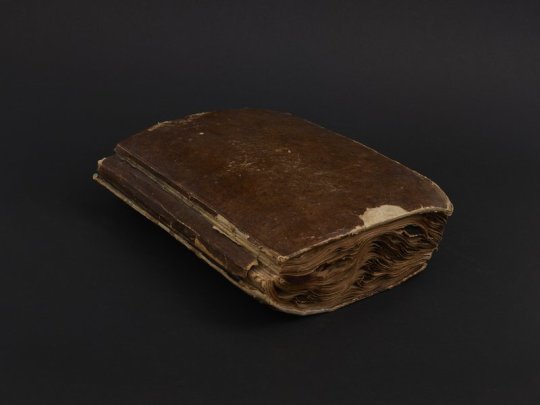
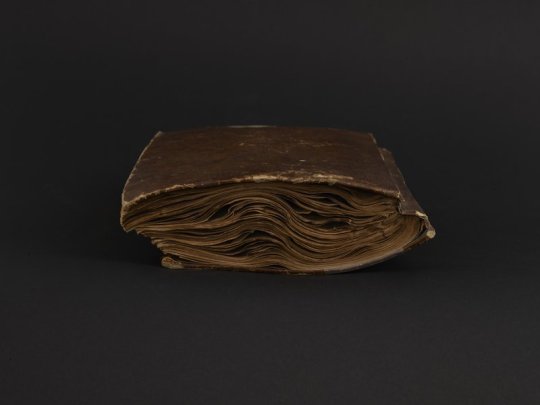
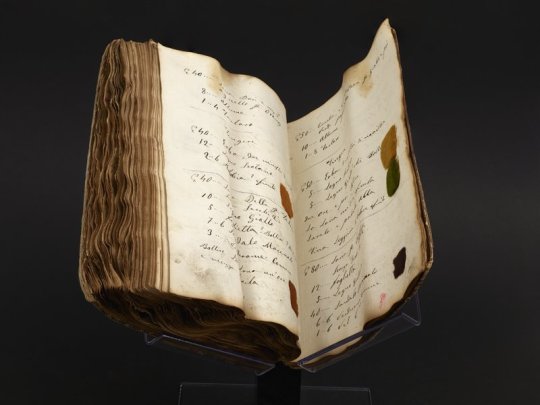

Italian Dyer's Notebook
Autograph manuscript, circa 1856-1866
This warped and worn nineteenth-century Italian manuscript appears to be a working manual and color inventory of a wool dyer in mid-nineteenth-century Italy. The handwritten entries are dated between 1856 and 1866, suggesting that the notebook was used and added to over a period of time. The work includes more than 500 numbered and itemized recipes for dyes. Recipes are illustrated with more than 800 wool and fabric samples adhered to the pages. The samples range in colors from shades of brown to vivid fuchsia, turquoise, and mustard. The samples include fabrics of wool, felt, and cotton, as well as raw wool and coils of yarn. Ingredients listed include mud, urine, arsenic, and vitriol. Pages 192-219 contain longer descriptions of dying processes, one attributed to Giacomo Udinese and another to Cesare Bizzi.
Check it out on our digital collections site.
#colors#colors in textiles#colorfastness#dyes#dyes and dyeing#textiles#wool#italian manuscripts#manuscripts#rare books#old books#rare book#dye samples#19th century#othmeralia
537 notes
·
View notes
Photo

Indigo Shibori
64 notes
·
View notes
Text

78 notes
·
View notes